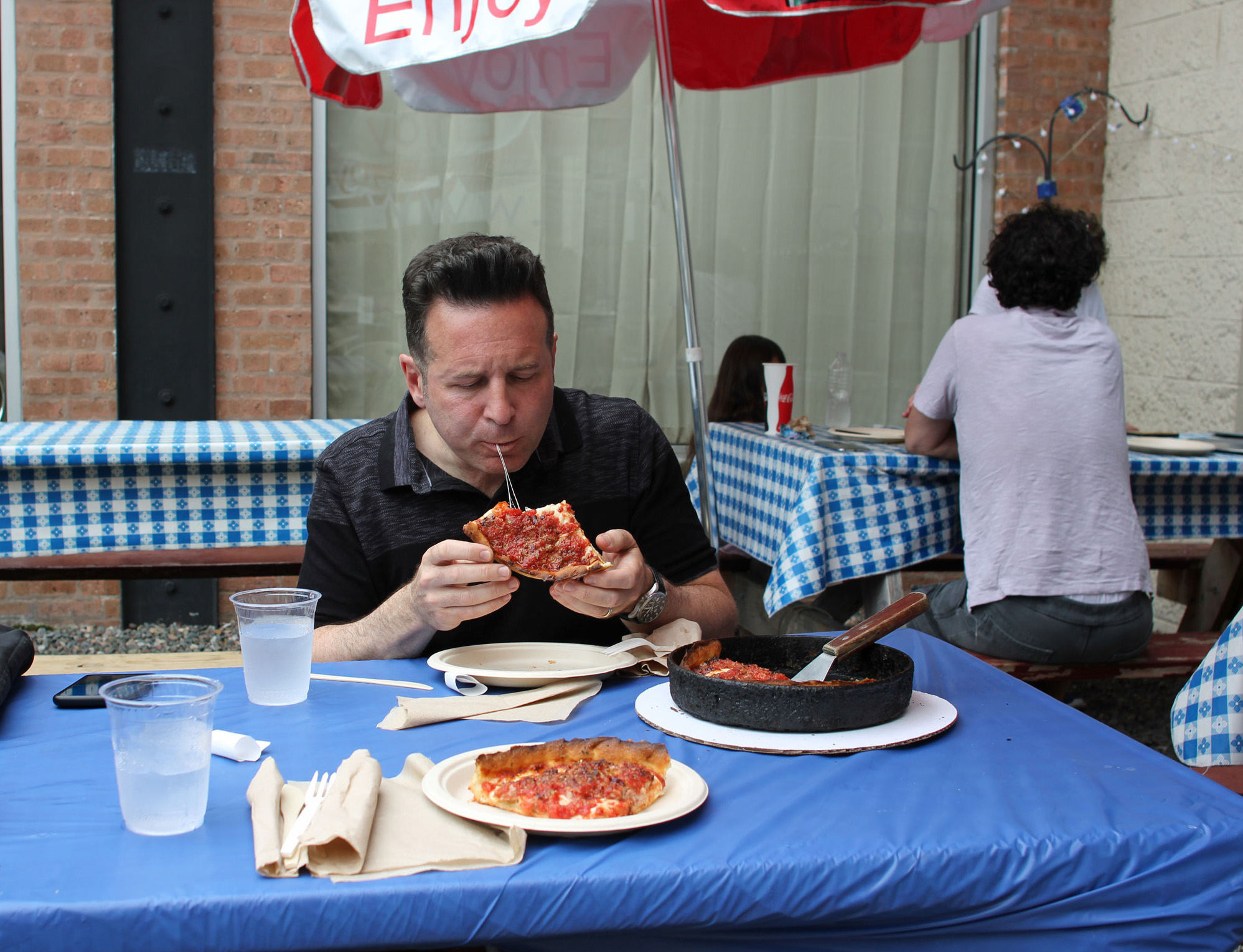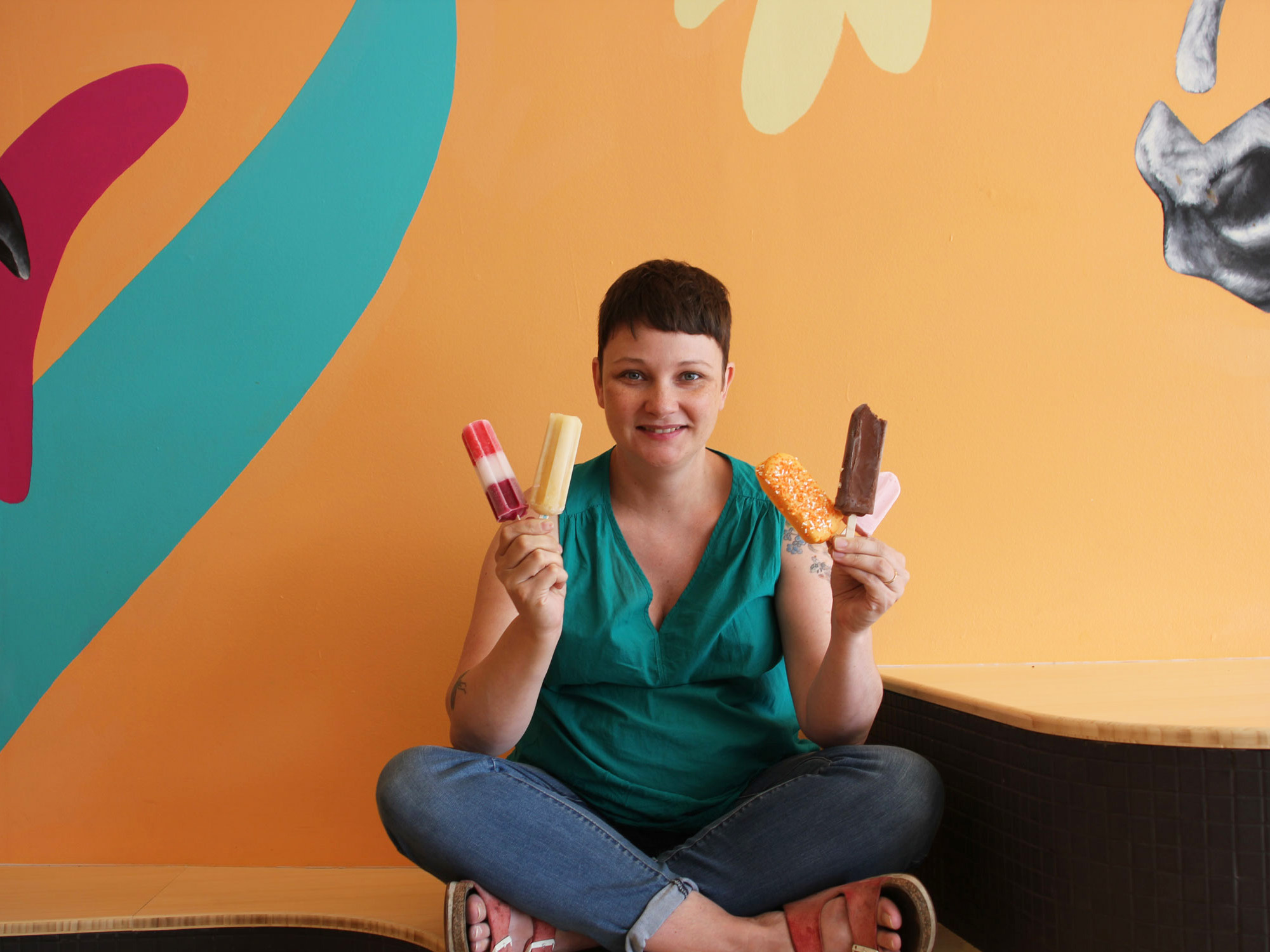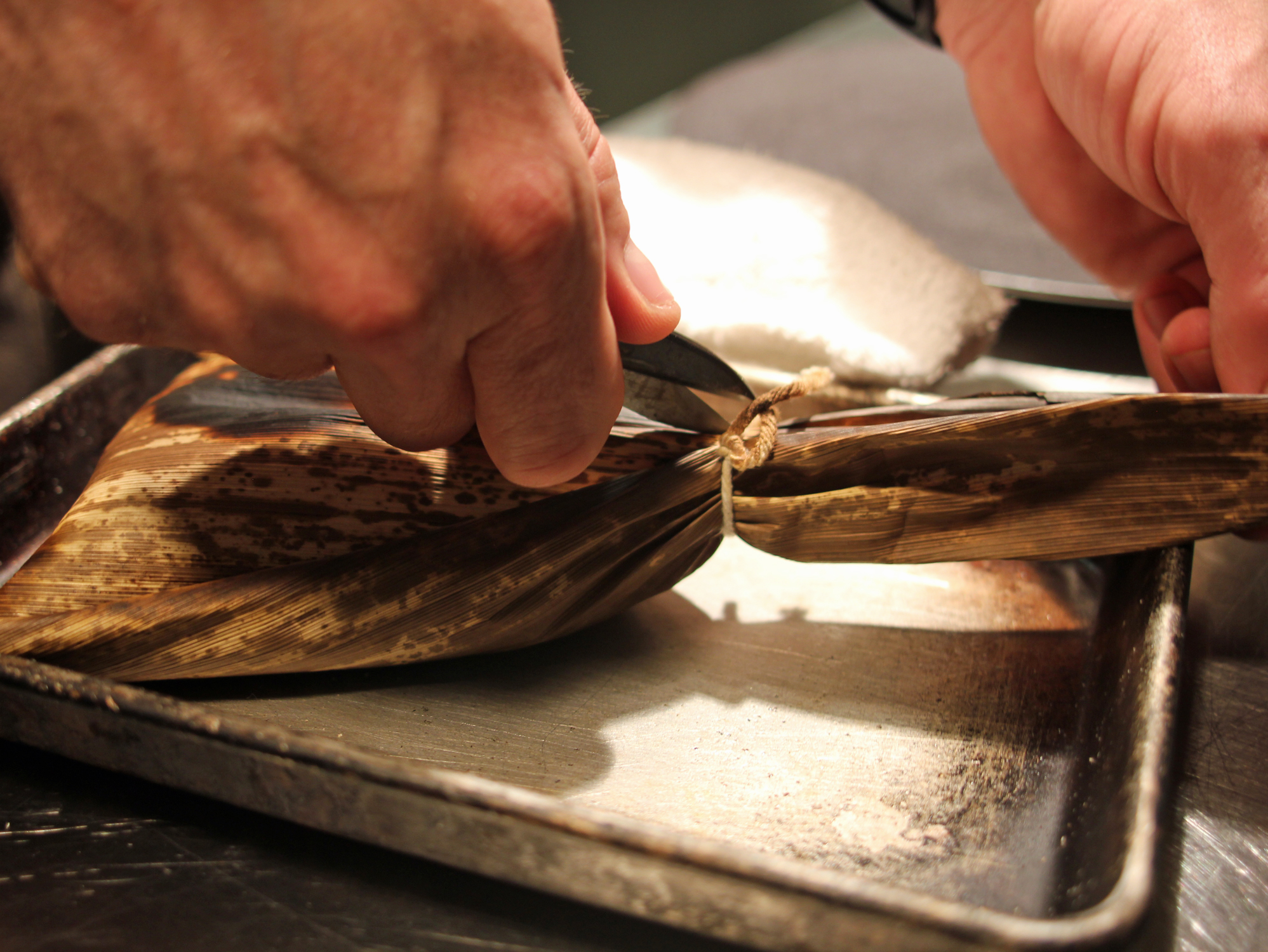OTTO PHAN INTRODUCED HIMSELF TO CHICAGO by telling Eater that he was moving here from Austin to win two Michelin stars, and by telling the Tribune “There’s no good sushi in Chicago.”
Who are you again, son?
Phan admits a bit sheepishly, “I did that interview when I was very upset. I was having a hard time getting the ingredients that I needed for a tier 1 city like Chicago when I could get them in Austin, Texas. I was being told, Otto, this ingredient is very expensive, the only person that would be using it would be you, so I don’t want to stock it.”
But whatever his mood that day, Phan is an unalloyed booster of Chicago and the possibilities it offers him. “I’m here in Chicago and I’m enjoying Chicago very much. Chicago is a city of dreamers,” he says. Surprisingly, he even found the process of opening a restaurant here (he served his first diners two weeks ago today) easy: “It took me a year to open up in Austin. Here, I have pretty much the exact same setup, and I was able to open up in six months. And six much easier months.”
“Mob towns run very efficiently,” he adds, not really helping.
Matthew Odam, whom Phan credits as the Austin restaurant critic who got him first and best, wrote that “thinking about sushi must take up about 90 percent of the chef’s brain.” That’s certainly the impression I got during two long sessions interviewing/hanging out with him, during which I started to contemplate a book called The Sushi Sayings of Otto Phan. Phan has deeply held convictions on the topic, and is good at making them into quotable sayings. He also has high opinions of his skills, to be sure, but I didn’t find him arrogant—I admired that he wants us to want better, and to be the one who brings it to us.
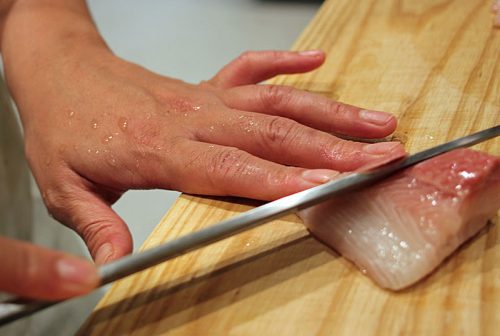
Slicing kampachi, yellowtail amberjack
“It’s not a risk at all,” he says of opening a $220-per-person sushi restaurant here. (That includes service and tax, so think of it as being in roughly the same $170-ish tasting menu price range as Schwa or El Ideas.) “We’re in a market with a ton of tasting menus at this price point. Second city—I don’t feel it. Chicago’s a tier 1 city.”
And a tier 1 city needs world-class sushi, which Chicago doesn’t have—you can have a nice $60 sushi meal, but not much more. “In Chicago there isn’t that one iconic sushi restaurant, so I wasn’t sure how receptive Chicago would be. But so far my clientele has been fantastic, very sophisticated. You always worry, can people tell a difference, but I’ve been pleasantly surprised. Is Chicago ready for this? Chicago’s more than ready for this. It’s been waiting for it for a long time.”
He swings back to the light social media roasting he took for his comments earlier in the summer. “Look, people talk shit on the internet, they can talk shit all day, but the people who come into my place and give me a chance, they know already, [saying Chicago lacks good sushi] is not that controversial. And if you think it’s controversial, would you rather lie, or be true and a little butthurt?”
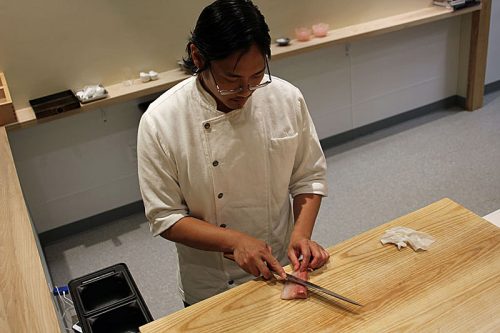
Otto Phan at Kyōten Chicago
OKAY, SO WE NEED BETTER SUSHI. Why should we think Otto Phan is the one to bring it to us?
He was born in Houston to immigrant Vietnamese parents. “I was one of those boys that always wanted to go away, but not run away,” he says. At 18 he went to Austin and started learning the restaurant world, working for Tatsu Aikawa and Takuya Matsumoto, who now have the Ramen Tatsu-Ya chain. By his mid-20s, he had ambitions beyond what Austin could teach him, and so he went to New York to look for a new master. The names he added to his resume were as good as could be had.
He teaches you that there’s a dream beyond a dream. Green onions can be cut thinner, somehow, and you need to go find it.
“Nobu taught me the technical skill part,” he says. “There are differences between Nobu restaurants, but Nobu New York is a very rigid and consistent training process, everything needs to look—the—same,” emphasizing the last two words staccato to make it clear he doesn’t mean 90% the same, he means, the same. “I know that if an ex-Nobu or Morimoto guy comes in, he’s going to be able butcher fish, do nigiri, do rolls.”
Nobu taught him his skills; Masa, New York’s first three-Michelin-star sushi restaurant, fired his imagination. “Masa is a completely different level. That’s the only place where I worked where food was about a feeling rather than a recipe,” he says. “He teaches you that there’s a dream beyond a dream, and you need to go out there and find it. Green onions can be cut thinner, somehow, and you need to go find it. You’re stuck in positions where you’re sharpening a knife three or four times a day. You don’t touch anything green until you sharpen your knife.”
After a couple of years in New York, though, “I was very tired, ready to just rest a bit, live life a little bit,” he says. “But eventually the bug gets you again. It’s hard going from Masa back to Austin where you’ve progressed way up here and Austin’s still here. That’s when you’ve got to open your own thing.”
Gallery: From Rice to Nigiri at Kyōten
I FINALLY GET TO GO INSIDE THE SPARE, SIMPLE ROOM that is Kyōten on my second time talking with Phan—the first time he locked his keys inside, so we went to the nearest coffee shop to talk. There’s a handsome wooden bar, where seven patrons at a time can sit along two sides, while Phan and his assistant Brandon prepare the food in front of them. And… that’s pretty much it; the decor is on the low end of minimalist. That may seem a bit strange in America, but it looks almost exactly like the setup at my one high-end sushi experience in Tokyo, eight-seat Sushi-Ya (which Phan has also been to). Chef, fish, diners, concentration. That’s what sushi is about.
And rice. “Rice plays a central role here, it’s basically a rice shop,” he says. This is one of the rare cases where Phan comes close to spouting a cliché—”the most important part of sushi is the rice” is one of those Zen paradoxes that sushi chefs say to make sushi more mysterious as an art form. Ninety percent of sushi is mental, the other half is physical.
But it is pretty much what Phan believes. “We’re super crazy rice-centric. It’s the one area where—okay, my rice is crazy expensive, but at the end of the day it’s not as expensive as fish. Rice is the one thing where, if you can focus on it, it levels the playing field.”
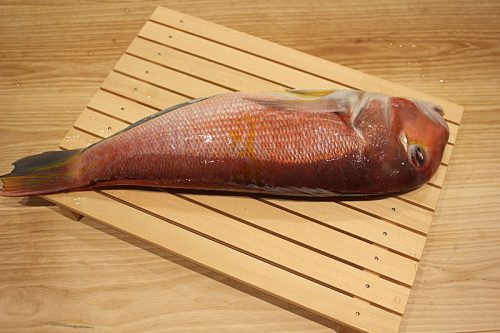
Amadai, Japanese tile fish
He lays out two bowls of dry rice. One is a brand called Tamaki Gold—”This is the rice that you would see in almost any good sushi restaurant in America. If they’re serving less than this, I feel sorry for them.” It looks like typical sushi rice—stubby little short grains, translucent off-white.
The other is the rice he uses—which he doesn’t want to give away the name of. It’s noticeably bigger, like arborio rice for risotto. “I’m the only person using this specific varietal in the U.S.,” he says. “I stumbled on it binging on sushi in Japan. Once I tasted this rice, this was it.”
I ask him for more details on how he discovered it. “It’s a three star Michelin place in Fukuoka called, ironically, Gyoten, not Kyōten. He’s the youngest 3 Michelin star sushi chef. I like that young energy, it’s kind of an open book, what are you going to get?” he says. “The second I had it, I had to have this rice. I think he showed it to me because he knew it would be difficult to get, and insanely difficult to cook. I spent months and months of figuring out how to cook this rice in Austin.”
I expect that to be some exacting process over a hot stove, possibly involving his ancient Vietnamese grandma, but this is a Japanese cuisine, so he comes out from his storage closet with a bowl of cooked rice from a rice cooker. “You can’t do this rice with, like, a Wal-Mart grade cooker. I find that pressure-induction rice cookers are the only ones that can really cook this rice correctly. Mine was about $800.”
Cooked, the secret rice has plumped up like whole-grain oatmeal. Now Phan wants me to taste—tiny tastes, he warns me—the two vinegars he uses. Both are what’s known as red vinegars, made from both rice and the leftover mash from the sake-brewing process. Using the sake by-product started as a cost-saving measure, but Phan likes the rougher, more pungent flavor it imparts.
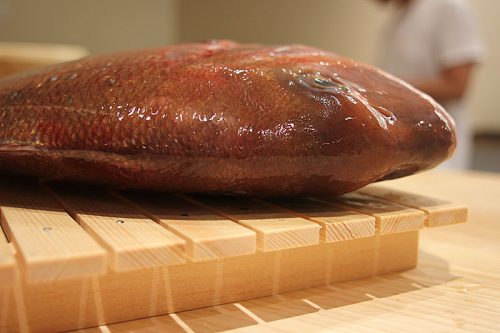
Kinmedai, golden snapper
“They’re essentially the same, fermented from rice and from sake mash,” he explains. “What makes the darker one different is that it’s been aged, like balsamic vinegar. It’s very intense and full-on umami. I first had rice in this style at Nobu when Chef was making special omakase rice, and it blew me away. It tasted like fish sauce, it was so intense.”
He divides the rice in half and mixes the lighter vinegar into the first portion with a plastic spatula. “I shouldn’t show you this, you’re supposed to use a wooden paddle to be authentic, but it’s too rough on this rice,” he says.
He stops mixing and shows it to me. “There’s a shimmer and a glow to it, and this glow is not just cosmetic—it is something you can taste. So rice is mixed at the last moment here. You want to eat it while the vinegar’s still getting soaked up.”
He mixes the darker vinegar into the other half. I ask what he uses each one for. “The lighter one goes with ‘normal’ fish—regular tuna, salmon, hamachi. The darker one goes with distinctively fatty fish. The threshold I use is an avocado—if you’re as fatty as an avocado, you get the dark one—medium and superfatty tuna, fatty mackerel, and wagyu. It’s not so much about the flavor as the fat content. I do make sushi for a worldly palate—a little more fat and a little more acid.”
As you might expect by now, he has firm opinions on how sushi rice is vinegared in America most of the time. “I am very biased toward an intense vinegar taste. Sushi needs that to be good. One of the differences between sushi rice in Japan and in America is that here, the rice is very sweet. In America it’s literally a Coca-Cola solution—equal parts vinegar and sugar. In traditional Edomae sushi, adding sugar to your sushi is considered a bit of a faux pas. ”
Then he admits that he sugars his vinegar anyway—a little, for the country he’s in, but not to Coca-Cola levels. “The less sugar you add, the harder it is to formulate that balance of acidity. I must have gone through 70 different recipes, the same ingredients every time. That shows you how delicate it is. Everybody uses the same ingredients, but everybody’s sushi rice tastes different.”
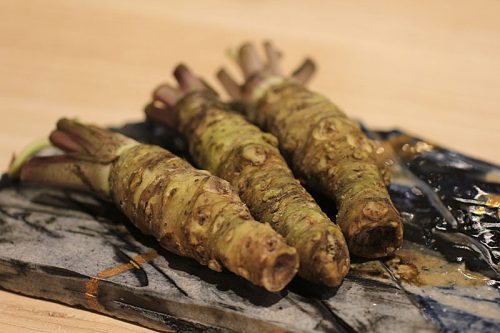
Fresh wasabi from Japan
He disappears into his back room for a moment and comes back with a whole fish, imported like much of his fish from Japan, which he takes to the sink to rinse. Most peoples’ assumption about sushi is that the fresher, the better, but Phan explains to me that that’s not so. “It needs to be super-fresh when it comes in. But this came in hard as a board, and it’s just not ready yet. It needs to be softer, I like soft fish.”
He’s found his theme, as he continues explaining while rinsing the fish. “The bigger the fish, the longer it takes. The snapper—it could go three or four days. Something like a Spanish mackerel, I won’t even touch it until after a week. It’s not even worth my two minutes to look at it.” He fills a tub with ice and sets the fish in it. “By the time I serve it, it could be two or three days old, it could be two weeks old. Some fish are a multi-step process—aged until soft, but then it’s cured in salt and sugar. And after it’s cured it needs to be aged for another four days, and then marinated overnight in soy sauce.”
Finally, he’s ready to cut me a piece of nigiri—to photograph, not to eat. He digs out from the cooler a chunk of kampachi that he served Saturday night, but by now is past its peak for top-grade sushi; he and his assistant will eat it later for staff meal. This part seems almost anti-climactic—a few deft slices to get a choice of cuts, a schmear of wasabi grated on sharkskin, a ball of rice, and he forms the piece. He makes his nigiri tall and round, and when I take too long taking its picture, he decides it’s slumped too much, and plumps it up again. Ready for my closeup, Sensei Phan.
And speaking of movie stars, at last we get the obligatory reference to the most famous sushi chef in the world, Jiro Ono. “Jiro is known for high intensity, very sharply vinegared rice,” he says. “My sushi is not like Jiro’s, but it falls in the same genre. And that’s how you’re able to make a bite of sushi so simple, and yet so good.”
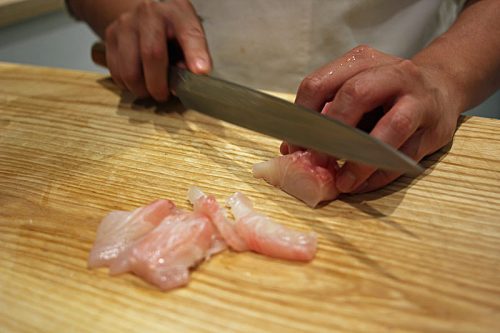
“I NEVER WANTED MY OWN RESTAURANT, I just wanted to learn. But there comes a point where you become too good [for a job], and once you’re too good, that’s when you open a trailer and you open a restaurant. My progression has been very natural,” Phan says.
Back in Austin from New York, he opened a sushi restaurant—in a trailer. “Chefs talk about opening a place—oh, I would be so badass, I would do it differently, my way. So are you gonna put up or shut up?” He says he decided, with that “young energy” he references a couple of times, “I could make the best sushi in the city out of a trailer, serving spicy tuna rolls. The balance was there, the acidity of the rice was there.”
He picked the name Kyōten because it isn’t really a word, but it kind of meant the edge of the sky—dining under the stars, as you do from a food trailer. It also implied the worldview he had now—”I don’t like to see the ceiling up above me.” Like Masa had taught him, you can always aim higher.
From the trailer to a brick and mortar restaurant charging around $140 for an omakase (service and tax included, again). Kyōten Sushiko in Austin did well—it’s shut down for now, but he plans eventually to train someone in Chicago to take it over. But, he says, “I drew the sushi nerds but I couldn’t draw in the casual fine diner, really. People didn’t really know what to do with me. You look from city to city, there’s always a huge gap between the sushi nerds and the critics. Some cities have critics that are knowledgeable about sushi and can nerd out on sushi. I was very lucky to have a critic like Matthew Odam who knew good sushi and could say, ‘He makes amazing sushi, but you’re kind of eating in a closet space.'”
By now, he was experienced as both chef and owner—which, he says, “makes me the luckiest chef in the world”—and he set his eyes on looking for somewhere to make a bigger splash. With an audience used to paying more for a tasting menu experience—and what’s the first part of most tasting menus if not, basically, a set of Japanese-influenced seafood courses?
“Even from the trailer I knew that I was going to go to a big-time city,” he says. He believed that with his skill level, he could be the top sushi chef in any city… that wasn’t named New York. “Most sushi chefs are from Japan, and if you’re a hotshot in Japan, you want to be in New York,” he says. “In the minds of Japanese people, New York is the center of the world. That leaves kind of an empty market for omakase everywhere else in the country, in Chicago and, I’ll be honest, even in California.”
He continues, “Sushi’s a very special thing, it takes special talent. People talk about the ingredients all day, but actually it’s not in the ingredient game as much as it is a talent game. You see ramen going through the whole country, but you see omakase not going through the whole country, because it takes special talent.”
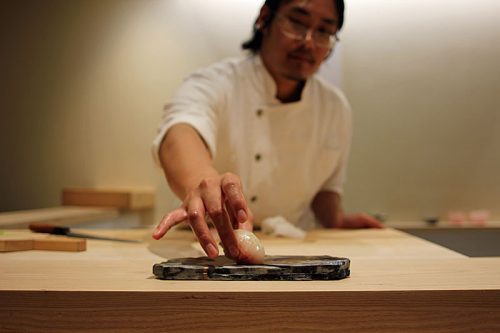
AND THERE WAS ONE OTHER THING Chicago had—Michelin. I tell him I don’t entirely approve of the fascination Michelin holds in the Chicago food community, since it is so aimed at out-of-town visitors and misses much of what’s so good about our scene on the local level. But Phan says, “I understand if you’re doing Mexican or other types of cuisines, who cares about Michelin. But they judge sushi well in a world that doesn’t judge sushi well. They are very consistent in the world of sushi.”
He recognizes that his stated goal of even one star—there’s only one two star sushi restaurant in America, Ginza Onodera in New York, and only Masa has three, so don’t even think about any of that yet—remains ambitious and possibly far off in his future. Even with Michelin’s adjusted expectations for Japanese minimalism, the room will need something to get past being an empty space in an apartment building and become, like Sushi-Ya did, a little temple of sushi contemplation shutting the world out behind you. But you know, why not shoot for it? And as diners, why not be happy that someone is?
“I wanted to be in a Michelin-starred city, and Chicago is the only [Michelin-reviewed American] city, and one of the few in the world, that does not have a Michelin-starred sushi restaurant. It’s something that nobody’s even aiming for here, and how sad is that?” he asks. “And then people are going to be offended that some Austin, Texas boy, who’s not even Japanese, is coming into your city and reaching for it? I’m sorry if this is a little embarrassing for you, but get out of my way!”
Michael Gebert dreams of sushi as editor of Fooditor.
Latest
Join the Discussion
After you comment, click Post. If you're not already logged in you will be asked to log in or register with Disqus.

















